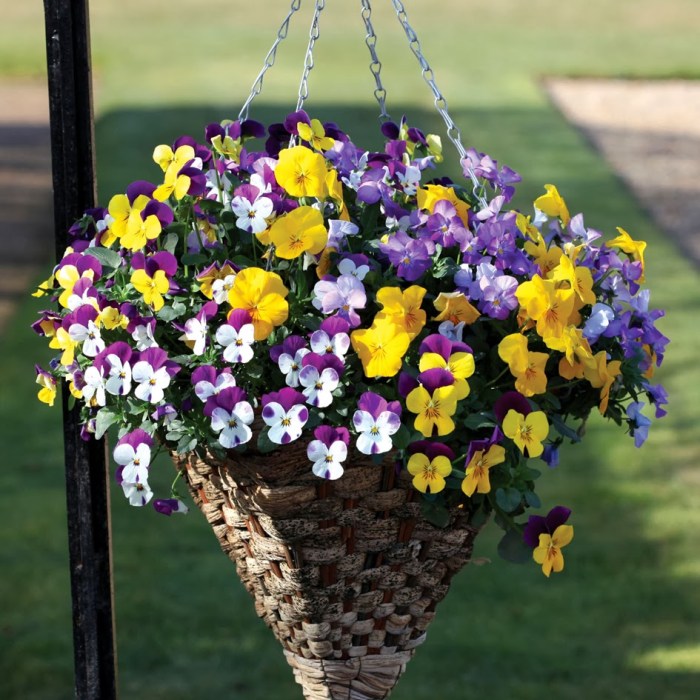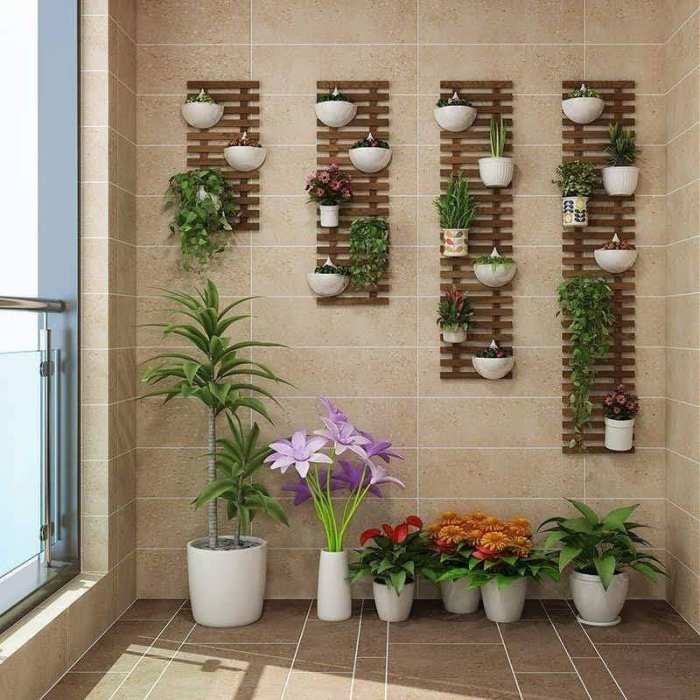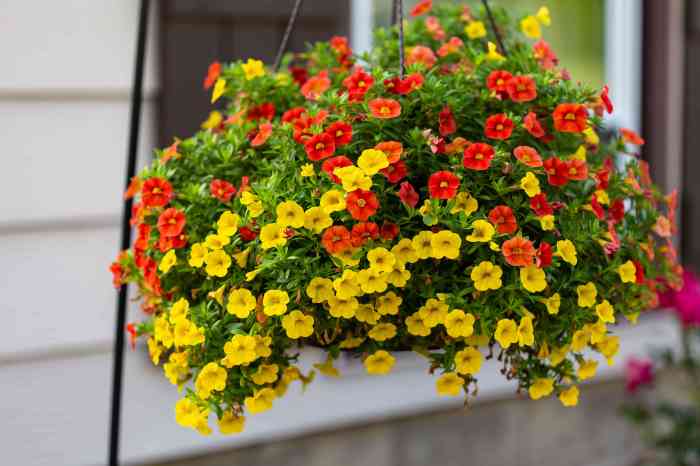Hanging plants and flowers, a captivating fusion of nature’s beauty and interior design, offer a unique way to transform living spaces into vibrant and serene oases. With their cascading foliage and blooming hues, these aerial wonders create a sense of tranquility and add a touch of the outdoors to any room.
Whether you’re a seasoned plant enthusiast or just starting your horticultural journey, this comprehensive guide will provide you with all the knowledge and inspiration you need to create stunning hanging plant displays that will elevate your home decor and bring a touch of nature into your daily life.
Plant Varieties

Hanging baskets provide an excellent way to add greenery and color to patios, balconies, and other outdoor spaces. When choosing plants for hanging baskets, it is important to consider the growth habit, foliage characteristics, and flowering season of each variety.
Some of the most popular types of plants for hanging baskets include:
Ferns
Ferns are a classic choice for hanging baskets. They have delicate, feathery foliage that adds a touch of elegance to any space. Ferns prefer indirect sunlight and well-drained soil.
- Boston fern ( Nephrolepis exaltata)
- Maidenhair fern ( Adiantum capillus-veneris)
- Asparagus fern ( Asparagus setaceus)
Succulents
Succulents are another great option for hanging baskets. They are drought-tolerant and require minimal care. Succulents come in a wide variety of shapes and sizes, so you can find one that fits your style.
- String of pearls ( Senecio rowleyanus)
- Burro’s tail ( Sedum morganianum)
- Echeveria
Vines
Vines are a great way to add height and drama to hanging baskets. They can be trained to climb up trellises or stakes, or they can simply cascade over the sides of the basket.
- Ivy ( Hedera helix)
- Clematis
- Morning glory ( Ipomoea purpurea)
Hanging Techniques

Hanging plants and flowers adds a touch of elegance and freshness to any space. There are various techniques for hanging plants, each with its own advantages and disadvantages. Here’s a comprehensive guide to help you create a secure and aesthetically pleasing hanging arrangement:
Macrame Hangers
Macrame hangers are a popular choice for hanging plants due to their decorative appeal and versatility. They are made by knotting cords together to create intricate patterns. Macrame hangers come in a wide range of styles and colors, allowing you to match them to your décor.
However, they can be time-consuming to make and may not be suitable for heavy plants.
Hanging plants and flowers add a touch of greenery and color to any space, but not all plants can withstand the harsh conditions of full sun. Fortunately, there are several hanging plants that can tolerate the intense sunlight, making them ideal for sunny patios, balconies, and gardens.
Some popular options include trailing succulents, flowering petunias, and heat-resistant begonias. For more hanging plants that can tolerate full sun , consult a reputable gardening website or visit a local nursery.
Chains and Hooks
Chains and hooks are a simple and secure way to hang plants. Chains provide a sturdy support for heavier plants, while hooks are ideal for smaller, lighter plants. Chains can be adjusted to different lengths, making them suitable for hanging plants at various heights.
However, chains and hooks can be visible and may not be aesthetically pleasing for all spaces.
Hanging plants and flowers add a touch of elegance and freshness to any indoor space. For those who want to incorporate this aesthetic into their homes, hanging plants indoor provides a comprehensive guide on how to achieve the perfect hanging arrangement.
From choosing the right plants and containers to selecting the best hanging methods, the website offers detailed instructions and tips to help plant enthusiasts create a vibrant and flourishing indoor oasis with hanging plants and flowers.
Plant Hangers
Plant hangers are specifically designed to hold plants and come in a variety of materials, including metal, wood, and ceramic. They are usually suspended from the ceiling or a wall bracket and provide a secure and stable support for plants.
Plant hangers can be decorative and complement the style of your space, but they may not be as adjustable as chains or hooks.
Considerations for Hanging Techniques
- Plant Weight:Choose a hanging technique that can support the weight of your plant. Heavier plants require stronger supports, such as chains or plant hangers.
- Height:Consider the desired height of your hanging plant. Chains and hooks allow for more flexibility in height adjustment compared to macrame hangers or plant hangers.
- Aesthetics:Select a hanging technique that complements the style of your space. Macrame hangers add a bohemian touch, while chains and hooks provide a more modern look.
Container Selection
Selecting the appropriate hanging containers is crucial for the health and aesthetic appeal of your plants. Factors to consider include size, material, and drainage.
Container size should align with the plant’s root system and growth habit. Larger containers accommodate more extensive root systems and taller plants, while smaller ones suit compact plants with limited root growth.
Material Considerations, Hanging plants and flowers
- Terracotta:Porous and allows for good air circulation, but requires more frequent watering due to water evaporation.
- Plastic:Lightweight, durable, and available in various colors and shapes, but may retain moisture and restrict airflow.
- Metal:Durable and stylish, but can become hot in direct sunlight and may require additional insulation.
Care and Maintenance: Hanging Plants And Flowers
Hanging plants bring a touch of nature and vibrancy to any space. To ensure their health and beauty, proper care and maintenance are essential. Watering, fertilizing, and pruning are crucial aspects of keeping hanging plants thriving.
Monitoring Soil Moisture
Watering is a delicate balance. Overwatering can lead to root rot, while underwatering can stunt growth. The key is to monitor soil moisture levels regularly. Insert your finger into the soil up to the first knuckle. If the soil feels dry, it’s time to water.
Hanging plants and flowers bring a touch of nature and beauty to any home. For those looking to add a unique touch, hanging succulents bunnings offer a low-maintenance and stylish option. These succulents come in a variety of shapes, sizes, and colors, making them a versatile choice for any décor.
From trailing varieties that cascade over the edges of pots to compact rosettes that add a touch of whimsy, hanging succulents bunnings are a perfect way to add a touch of greenery to any space. They require minimal care, making them ideal for busy individuals or those new to gardening.
Watering Techniques
Water thoroughly until it drains out of the drainage holes. Avoid letting the soil become soggy. Allow the top inch of soil to dry out before watering again. During hot, dry weather, plants may need more frequent watering.
Fertilization
Fertilizing provides essential nutrients for healthy growth. Use a balanced liquid fertilizer diluted to half strength every two to three weeks during the growing season. Avoid overfertilizing, as it can burn the roots.
Pruning
Pruning removes dead or overgrown stems and encourages new growth. Use sharp, clean shears to make precise cuts. Prune lightly to maintain shape and remove any diseased or damaged leaves.
Creative Display Ideas

Hanging plants offer a captivating way to add greenery and vitality to any space. By incorporating multiple plant species and textures, you can create visually stunning displays that transform your living areas into lush havens.
Designing a Multi-Species Hanging Plant Display
To achieve a harmonious and visually appealing display, consider combining plants with varying leaf shapes, colors, and textures. For instance, you could pair trailing pothos with bushy ferns and variegated spider plants. Alternatively, you could create a monochromatic display using different shades of green, such as emerald-hued succulents and lime-colored philodendrons.
Hanging Plant Arrangements for Different Spaces
| Space | Arrangement Examples |
|---|---|
| Patio | Tiered macrame hangers with trailing plants like ivy and begonias |
| Balcony | Vertical wall planters filled with a mix of succulents, herbs, and trailing flowers |
| Indoor Room | Hanging baskets suspended from the ceiling with trailing plants like spider plants and pothos |
Gallery of Innovative Hanging Plant Displays
For inspiration, explore a gallery of creative hanging plant displays that showcase innovative and visually appealing arrangements. From intricate macrame hangers to geometric terrariums, these displays offer endless possibilities for transforming your living spaces into green oases.
Closing Summary

In conclusion, hanging plants and flowers are a versatile and rewarding addition to any home. By understanding the different plant varieties, hanging techniques, container selection, care requirements, and creative display ideas, you can create captivating arrangements that will enhance your living spaces and bring joy for years to come.
So, let your imagination soar, embrace the beauty of nature, and transform your home into a sanctuary of tranquility and visual delight with hanging plants and flowers.
FAQs
What are the most popular hanging plant varieties?
Some of the most popular hanging plant varieties include ferns, succulents, vines, and trailing plants such as pothos and philodendrons.
How often should I water my hanging plants?
The frequency of watering will vary depending on the plant variety, container size, and environmental conditions. As a general rule, water your plants when the top inch of soil feels dry to the touch.
How can I create a secure hanging arrangement?
There are various ways to create a secure hanging arrangement, including using macrame, chains, or hooks. Ensure that the hanging system can support the weight of the plant and container, and that it is securely attached to a stable structure.